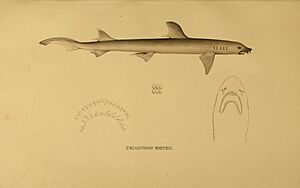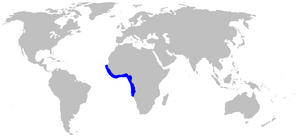Barbeled houndshark facts for kids
Quick facts for kids Barbeled houndshark |
|
|---|---|
 |
|
| Conservation status | |
| Scientific classification | |
| Genus: |
Leptocharias
|
| Species: |
smithii
|
 |
|
| Range of the barbeled houndshark | |
| Synonyms | |
|
Mustelus osborni Fowler, 1923 |
|
The barbeled houndshark (Leptocharias smithii) is a special type of ground shark. It's the only member of its unique family, Leptochariidae. This shark lives near the ocean floor in the eastern Atlantic Ocean, from Mauritania to Angola. You can find it in waters about 10 to 75 meters (33 to 246 feet) deep. It loves muddy places, especially near river mouths. This shark is easy to spot because of its very thin body, small whiskers (called barbels) near its nose, and long grooves at the corners of its mouth. Its teeth are also different between males and females. The biggest barbeled houndshark ever found was about 82 centimeters (32 inches) long.
This shark is a good swimmer and eats many different things, like bony fishes, small ocean creatures (invertebrates), and even fish eggs. Female barbeled houndsharks give birth to live young, usually about 7 babies at a time. The baby sharks grow inside the mother, getting food from a special round structure called a placenta. The International Union for Conservation of Nature (IUCN) says the barbeled houndshark is a "Vulnerable" species. This means it's at risk because many are caught by fishing boats for their meat and skin.
Contents
The Barbeled Houndshark: A Unique Ocean Dweller
Discovering the Barbeled Houndshark
The name Leptocharias was first used by a South African doctor and zoologist named Andrew Smith in 1838. A year later, two scientists, Johannes Müller and Friedrich Henle, described the species but called it Triaenodon smithii. Later, other scientists realized that Leptocharias was the correct name for this shark. For a while, it was grouped with other shark families like Carcharhinidae and Triakidae. But because it has so many unique features, scientists eventually decided it needed its own family, called Leptochariidae. The first official specimen, an adult male, was found off the coast of Cabinda Province, Angola.
Where Does It Live?
The barbeled houndshark lives along the western coast of Africa. Its range stretches from Mauritania all the way down to northern Angola. Some scientists think it might even swim as far north as the Mediterranean Sea. These sharks prefer shallow coastal waters, usually between 10 and 75 meters (33 to 246 feet) deep. They like water temperatures between 20 and 27 degrees Celsius (68 to 81 degrees Fahrenheit). You'll often find them close to the ocean floor, especially in muddy areas near river mouths.
What Does It Look Like?
The barbeled houndshark has a very thin and sleek body. Its eyes are oval-shaped and have special inner eyelids that can cover them. Behind its eyes, it has two tiny holes called spiracles. Each nostril has a thin, whisker-like growth called a barbel. Its mouth is long and curved, with very long grooves at the corners that reach onto both jaws.
Special Features
This shark has many small teeth, with 46 to 60 rows in the upper jaw and 43 to 54 rows in the lower jaw. Each tooth has a narrow point in the middle and two smaller points on the sides. Interestingly, the teeth of male and female sharks are different! Males have much larger front teeth.
It has two small dorsal fins, which are about the same size. The first dorsal fin is located between its pectoral (side) fins and its pelvic fins (bottom fins). The second dorsal fin is above its anal fin. The top edge of its caudal fin (tail fin) is smooth, and the lower part of the tail fin is very small. This shark is usually a plain light gray on top and whitish underneath. Males can grow up to 77 centimeters (30 inches) long, and females can reach up to 82 centimeters (32 inches) long.
What Does It Eat?
The barbeled houndshark seems to be an active swimmer. This is clear from its strong muscles, long tail, and small body. It eats many different creatures that live on the ocean floor and near the shore. Its favorite foods include Crustaceans like crabs, lobsters, and shrimp. It also eats small bony fishes such as sardines, anchovies, and flatfish. Sometimes, it even eats skate and flying fish eggs, octopus, and sponges. Scientists have even found strange things in its stomach, like feathers and plant pieces! This shark has a few known parasites, including tiny creatures called copepods.
Reproduction and Life Cycle
The larger front teeth of male barbeled houndsharks might be used during mating. This species gives birth to live young, which is called viviparous. When the baby sharks inside the mother have used up their yolk supply, they get food through a special connection. This connection is formed from the yolk sac and acts like a placenta. What's really unique about this shark is that its yolk-sac placenta is shaped like a globe or sphere, which is different from any other shark.
Off the coast of Senegal, female barbeled houndsharks usually give birth to about seven pups around October. Their pregnancy lasts for at least four months. The largest baby sharks found before birth were about 20 centimeters (8 inches) long. This is likely how big they are when they are born. Males become old enough to reproduce when they are about 55 to 60 centimeters (22 to 24 inches) long. Females reach this stage when they are about 52 to 58 centimeters (20 to 23 inches) long.
How Do Humans Interact with It?
The barbeled houndshark is harmless to humans. It is quite common and important for the economy in the West Africa region. Fishermen, both small-scale and commercial, catch these sharks by accident (this is called bycatch) using hooks, nets, and trawls. When caught, the shark's meat is sold fresh, smoked, or dried and salted. Its skin is also used to make leather.
The IUCN has listed the barbeled houndshark as "Vulnerable." This means its population is decreasing and it's at risk. There is a lot of fishing in the areas where it lives. However, scientists don't have enough specific information about how many are caught each year to fully understand the impact.


